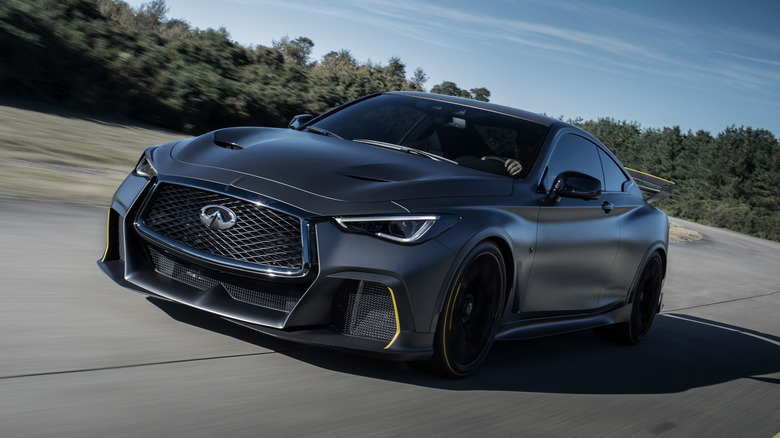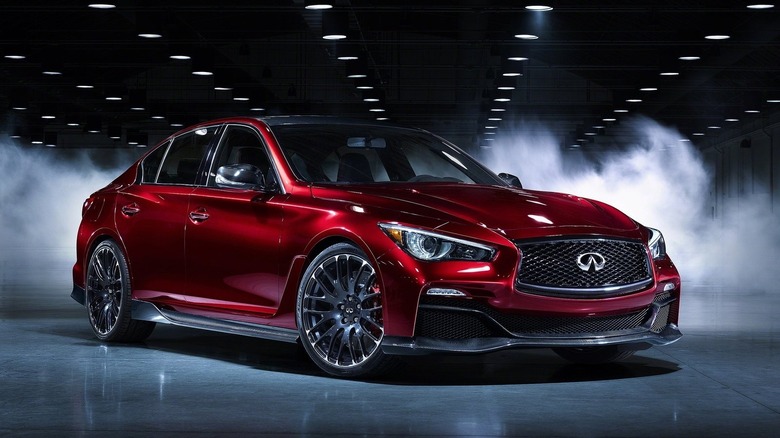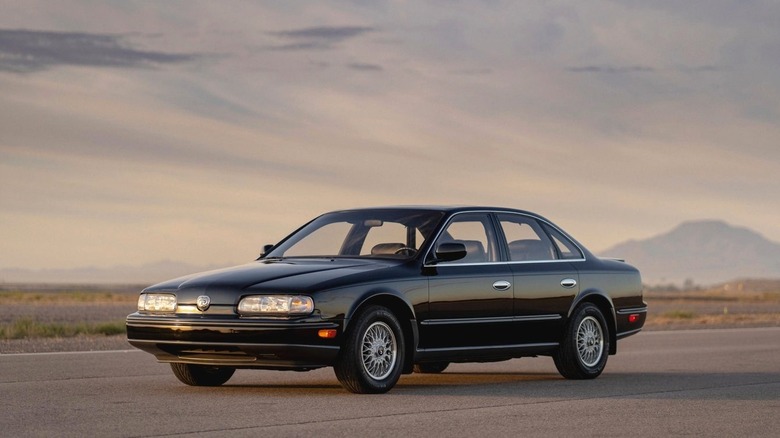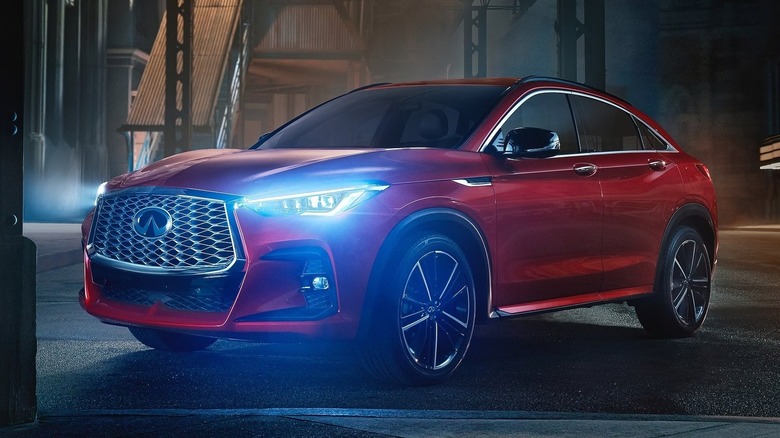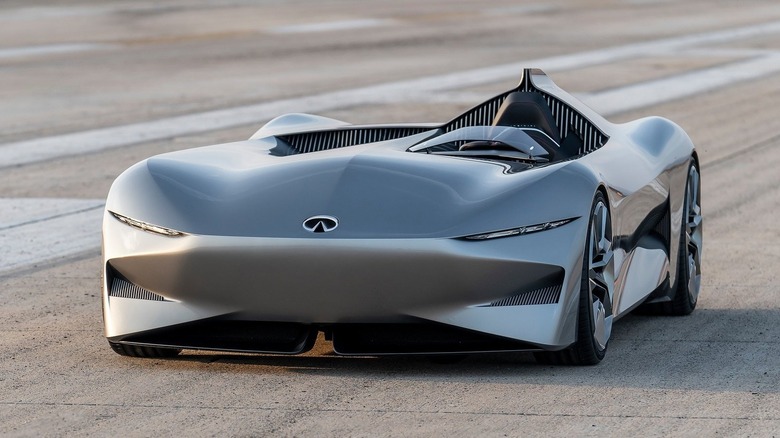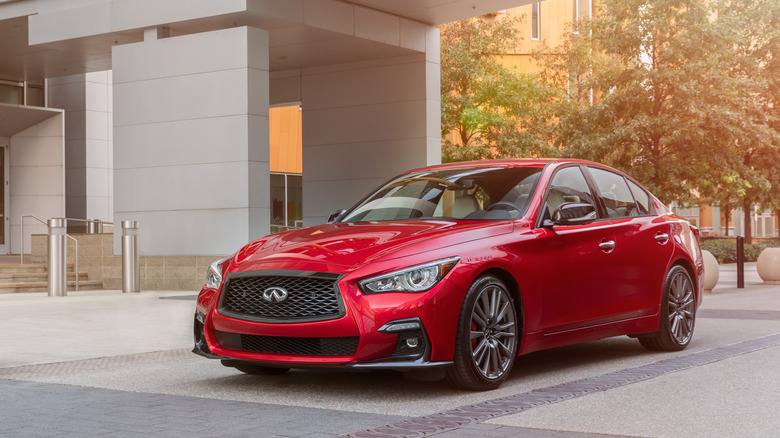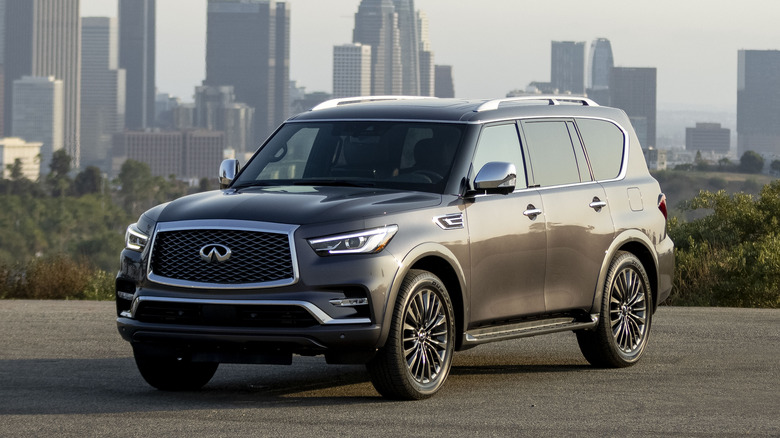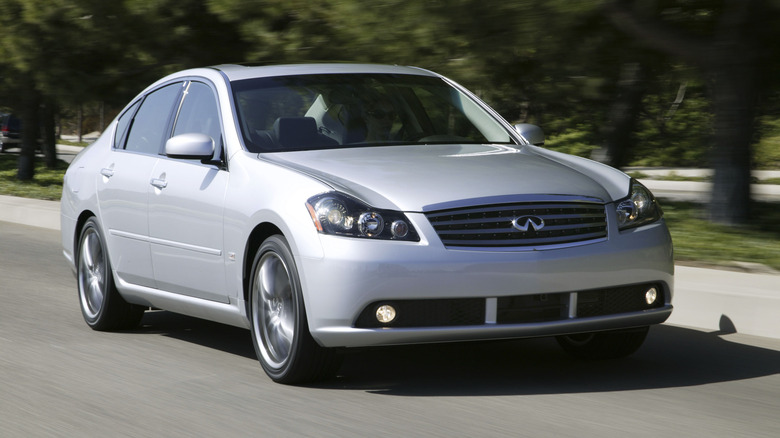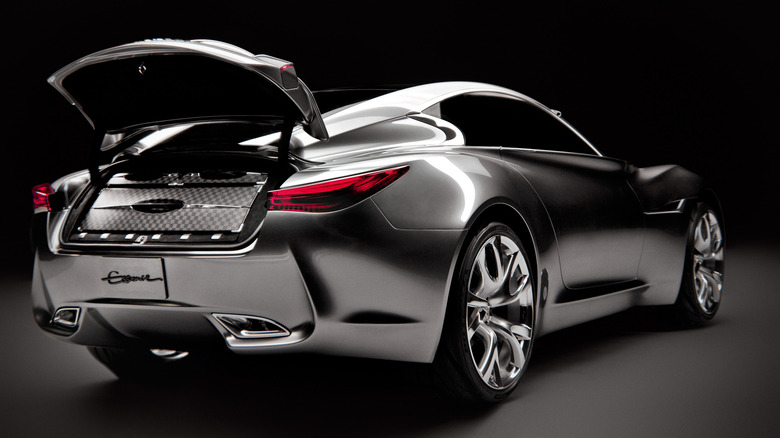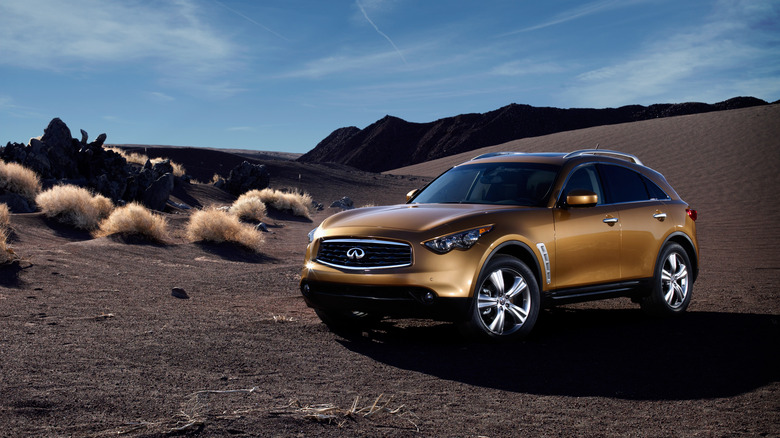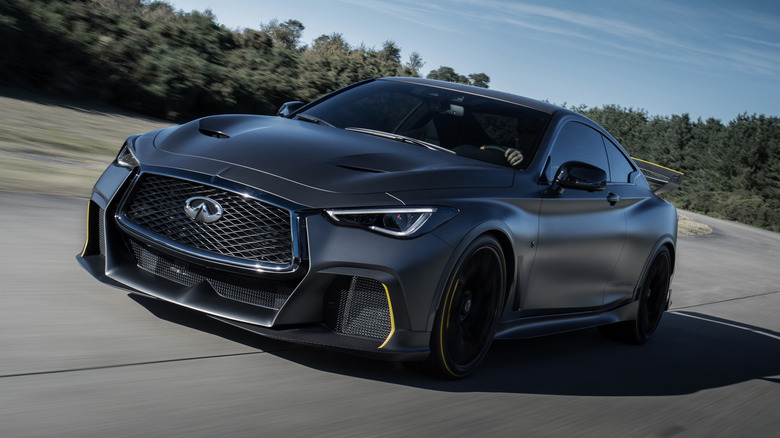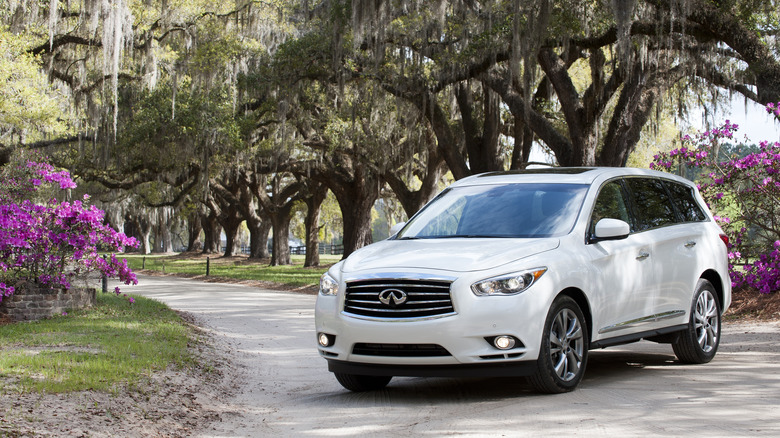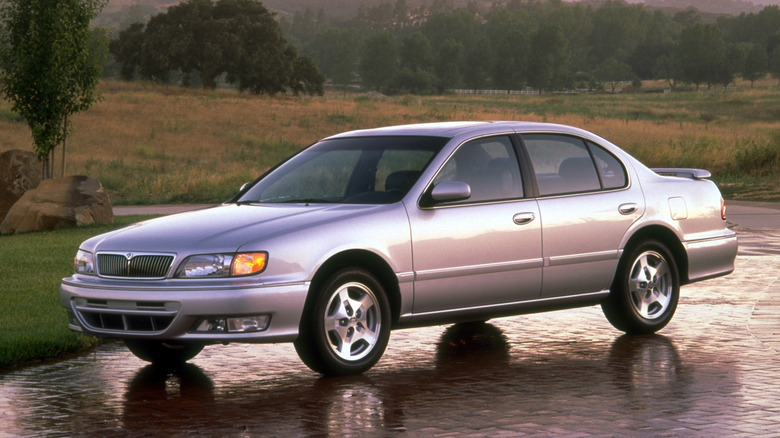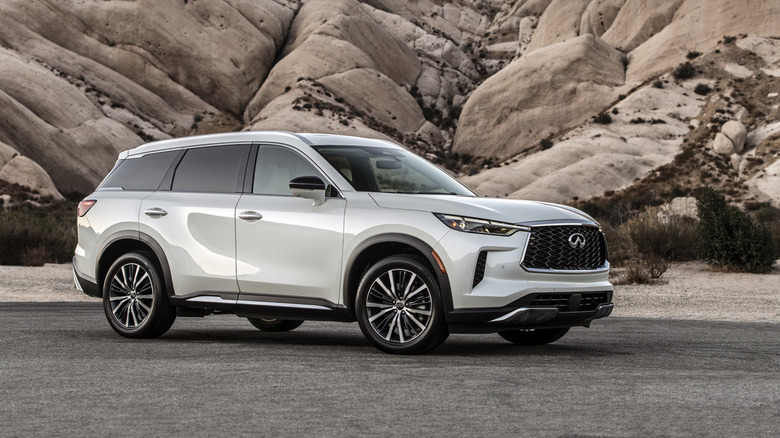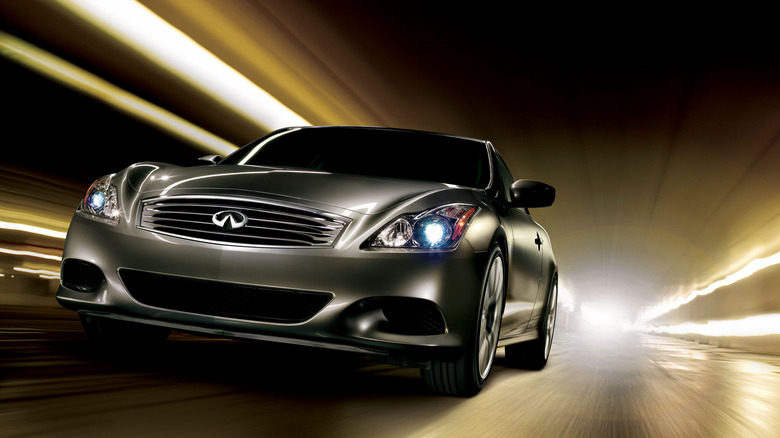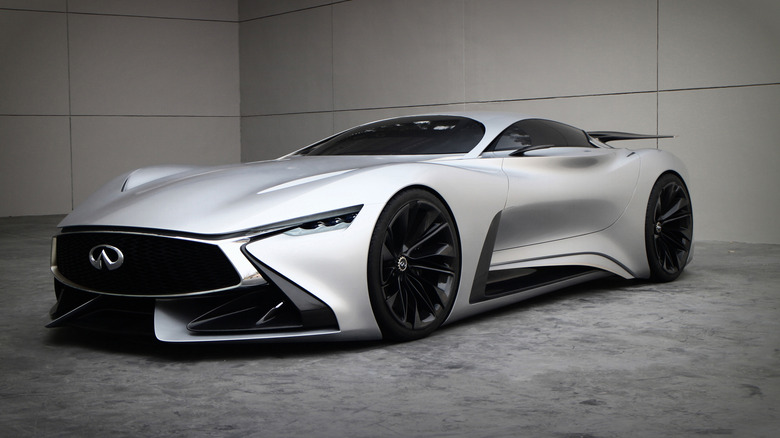The 15 Best Infiniti Cars Of All Time
Infiniti was formed in the mid-Eighties as a luxury offshoot of Nissan. Its aim was to take on the established brands from Europe and America, as well as to compete against fellow Japanese brands Lexus and Acura. Infiniti launched its first car in the US in 1989, but it's always struggled to claim the same market share as its rivals. It's fair to say that the company's lineup has featured its share of forgettable vehicles over the years, but there have also been some gems hidden between them, although they often don't get as much credit as they deserve due to Infiniti's limited brand recognition.
The brand has also released a number of attention-grabbing concept cars with plenty of production potential, but it has a habit of axing these projects mid-way through development. Since 2017, its sales have been on a constant decline in the US, and the brand pulled out of Europe altogether in 2020 for the same reason. So, now would be as good a time as any for Infiniti to release a new model that's so great that buyers can't help but take notice. Until then, these fifteen cars make up the brand's highlights so far.
Infiniti Q50 Eau Rouge
Infiniti competed in Formula 1 in partnership with Red Bull for 10 years between 2010 and 2020, and during that period, it unveiled several concept cars showcasing how F1 technology could be applied to a road car. One such concept was the Q50 Eau Rouge, which debuted at the Detroit International Auto Show in 2013. The concept was a modified version of the production Q50, and featured a 560 horsepower twin-turbo V6 engine that was borrowed from the Nissan GT-R. It also featured a number of aerodynamic improvements that were developed with input from Red Bull Racing.
At the time it was unveiled, Infiniti revealed that the plan was to make a small production run of the Eau Rouge, although this never happened. A four-door luxury super-sedan would have arguably made an excellent addition to the brand's lineup, competing against the likes of the BMW M5 and becoming a halo product for the Infiniti line. However, Infiniti bosses decided that the car wasn't worth the cost of development, given the small number of units they were likely to sell.
Infiniti Q45
The first Infiniti model that debuted in 1989, the Q45 was a V8-powered luxury sedan that shared a lot of its parts with the Japanese-market Nissan President. The car launched in 51 dealers across the US and aimed to take on the European and American luxury brands that dominated the market at the time. According to MotorTrend, it used the BMW 7 Series and Mercedes-Benz 560 SEL as benchmarks, but in reality, it most closely competed with the Lexus LS400. With 278 horsepower on offer from its V8 engine, the Q45 was capable of sprinting from 0-60 mph in 7.2 seconds and could pull a quarter-mile time of 15.4 seconds, both of which were impressive figures for the era.
The car drew praise for its performance and its cutting-edge four-wheel steering system, called HICAS, which helped make the car feel more nimble despite its large size. It also featured active suspension which, according to Motor Authority, was so effective at preventing body roll that it drew complaints for making passengers feel queasy. Sales of the car were initially strong thanks to an unusual ad campaign that featured images of nature and almost none of the car, creating intrigue among viewers and drawing them into Infiniti showrooms in their thousands. However, its sales figures never matched that of the Lexus LS400, a car that would prove integral in launching Toyota's luxury arm into the American mainstream while Infiniti remained largely on the sidelines.
Infiniti QX55
One of the common criticisms leveled at Infiniti in the past has been that it hasn't done enough to differentiate its cars from the crowd, but with the QX55, it's addressing that criticism head-on. The company describes the car as a "provocative crossover coupe," and its sharply sloping roofline is reminiscent of the BMW X4 and Mercedes-Benz GLC Coupe. However, it undercuts both of those cars in price, starting at roughly $47,000 including fees, while its rivals start at $52,000 and $53,000 respectively. The car shares its powertrain and most of its internal components with the QX50 SUV, with the main difference between the two cars being the QX55's striking body style.
In our recent review of the QX55, SlashGear found that its handling was more sprightly than Infiniti's other crossovers, with plenty of grip available in all conditions thanks to its all-wheel-drive system. Its acceleration was also befitting of its athletic styling, and it was one of the most engaging cars to drive in its niche segment. It remains to be seen whether the car will be able to tempt many buyers away from its German rivals, but the Infiniti can certainly hold its own against them in terms of both performance and value for money.
Infiniti Prototype 10
Unveiled in 2018, the Prototype 10 was a show car built to announce the brand's intention to transition to all-electric powertrains by 2021. It channeled the design of vintage speedster racing cars, but with a modern EV powertrain, working on the idea of "looking back to go forward," according to its designer. It shared a number of visual similarities with the Infiniti Q Inspiration concept that was shown off earlier the same year, but it ditched the roof and doors for a strikingly unique speedster design. The car's internal development nickname was reportedly "The Bathtub," because the low driving position meant that only the driver's head could be seen when sitting behind the wheel.
Despite Infiniti claiming its cars would be all-electric by 2021 at the time of the Prototype 10's reveal, the brand doesn't currently offer an EV at all. However, it recently re-iterated that it plans to make the switch to electrification in the future, perhaps by 2030. In February 2022, Nissan revealed plans for a US-built Infiniti EV to be launched in 2025, and the initial teaser images suggest that the design language used on the Prototype 10 might well carry over to this new production car.
Infiniti Q50 Red Sport 400
The compact executive car segment is a fiercely competitive one, with the BMW 3 Series and Mercedes-Benz C-Class leading the charge. Infiniti's entry into the field is the Q50, and the top-spec variant is the Red Sport 400. As its name suggests, the car makes 400 horsepower from a twin-turbo V6, and an optional all-wheel-drive system is on hand to ensure that the car remains grippy at all speeds. It's arguably one of Infiniti's best-looking models, with a silhouette that's just as stylish as the segment's best.
Another highlight of the Q50 Red Sport 400 is its exhaust note, which our review described as sounding "pretty darn glorious." With cars that sound this good, it's no wonder Infiniti hasn't rushed to electrify its lineup. However, the car is far from perfect, with a seven-speed automatic transmission that could use some fine-tuning, and a cabin that's beginning to show its age. It's not quite as complete a package as the likes of the BMW 3 Series, but for a performance-focused, left-field alternative to the segment's best-selling German cars, the Infiniti is a great choice.
Infiniti QX80
Infiniti's biggest, most imposing SUV got an overhaul for the 2022 model year that added a suite of new technology to help it keep up with its luxury SUV rivals. The car now comes with a new 12.3-inch touchscreen as standard, plus integrated Android Auto and Apple CarPlay. The QX80 is based on the Nissan Armada and shares its drivetrain, a 5.6L V8 that makes 400 horsepower and is able to pull the car along seemingly effortlessly. It's also one of the most spacious luxury SUVs out there, and it can tow up to 8,500 lb, more than many of its rivals.
Thanks to its hulking V8 and traditional proportions, it offers an old-school charm that very few of its contemporaries do. It's far from the fastest SUV in its segment, and it's not the most tech-laden, but the QX80's bulky proportions and chrome accents still give it an impressive road presence, one that's unmistakably Infiniti. With electrification just around the corner, this gas-guzzling SUV won't be around forever, but we'll certainly miss the silkiness of the QX80's V8 after it's gone.
Infiniti M45 (3rd generation)
An executive sedan with muscular V8 power, the third generation of the M45 debuted in 2006 and was a completely different car from its predecessor. Its driving dynamics were considerably sportier than the outgoing car, and its rear-wheel-drive setup paired with its V8 engine made for a surprisingly fun drivers' car. It was positioned between the G35 sport sedan and the flagship Q45, and its status as the middle child meant that it was often overlooked by buyers, but it didn't deserve to be. Car and Driver reviewed the M45 and praised its smooth transmission and torquey demeanor, even saying that driving it at speed around forest roads was "addictive," an unusually enthusiastic compliment for a mid-range executive sedan.
The M45 definitely had the chops to compete with the segment's best, but it was never a strong seller, perhaps due to the previous generation M45's decent-but-forgettable performance and uninspiring looks. The third-gen car was a significant improvement over its predecessor, but it seems like buyers never noticed, and the car struggled to take market share away from its European competitors. It was quietly replaced in 2010 after consistent low sales.
Infiniti Essence
The Essence concept was a 592 horsepower, rear-wheel-drive sports coupe, unveiled at the Geneva International Motor Show in 2009. It was built to show off the design cues and technologies that would be making their way into production vehicles over the following years. The car featured a hybrid gas-electric powertrain that could run on pure electric power at low speeds, allowing for zero-emissions travel. It also debuted a number of cutting-edge driver assistance features including backup collision prevention, a common feature now, but one that turned heads when it was shown off in 2009.
The car also came with a custom-made Louis Vuitton luggage set that fitted neatly into the rear trunk of the car, according to Motor1. It was reported that the car was insured for approximately €2,000,000 ($2,110,000), and the brand stated at the time of its release that the Essence was a show car only, with no chance of production. Even if a limited run of the car was considered behind closed doors, it seems very unlikely that anyone would pay Bugatti money to own anything with an Infiniti badge.
Infiniti FX50
A sporty SUV built to rival the Porsche Cayenne and BMW X6, the FX50 had its work cut out to divert attention away from its German competition. It won praise for its V8 engine and hot-rod like exhaust note, and its 0-60 mph time of 5.3 seconds was impressive for a crossover of its size. In a straight line, the FX50 could rival the Porsche Cayenne Turbo, although it struggled to match the class-leading BMW X6 around corners. It also won points for its appearance, which was distinctive yet stylish, much like its German rivals.
Arguably the biggest problem with the FX50 was the same issue that has plagued many of the brand's other models: its badge simply wasn't prestigious enough to win over buyers. If the car had been wearing a BMW, Porsche or Mercedes-Benz badge, it might have sold better, although it's worth pointing out that its interior wasn't up to the standards of any of those manufacturers. But, in general, the FX50 was limited mostly by the fact that it was an Infiniti, quite ironic considering that it's on a list of the brand's best cars. It's not all bad news though, as the car's rapid depreciation makes it a bargain used performance SUV today.
Infiniti Q60 Project Black S
The Infiniti Q60 Project Black S was built as an engineering test-bed to explore how F1-style dual-hybrid powertrain technology could be deployed in a road car. It featured the twin-turbo V6 engine from the Q60 Red Sport 400, plus a pair of heat-energy harvesting systems, called MGU-H and MGU-K. MGU-H (Motor Generator Unit – Heat) used the heat produced by the engine to generate electricity, and MGU-K (Motor Generator Unit – Kinetic), recovered power during braking. This dual-hybrid setup meant that extra power was almost constantly being harvested, giving the car a total output of 563 horsepower.
Infiniti seriously considered making a limited production run of the car, stating that powertrain development had reached the near-production stage in August 2019, and that a decision on whether to put the car into dealerships would be made in the coming months. However, the project then went quiet until March 2021, when Infiniti confirmed that the Project Black S had been shelved, with the departure of Infiniti boss Roland Krueger cited as the reason for the company's decision.
Infiniti JX35
It's not just Infiniti's performance-focused vehicles that deserve a spot on their highlights list, as cars like the JX35 prove that the brand can make excellent luxury family haulers too. MotorTrend reviewed the car in 2013 and was full of praise, reporting that the seven-seater left a good impression on every staff member who drove it. The goal of a car like this is to be comfortable, practical, and premium, and the JX35 ticked all those boxes with aplomb. Its electronically-assisted steering was reportedly light and responsive, and its brakes always felt predictable even when under heavy stress.
In a separate review, Car and Driver also praised its innovative suite of driver-assistance features, including its backup collision prevention system, a feature that was originally unveiled on the 2009 Essence concept. The car was based on the platform of the Nissan Murano but was stretched and widened, leading to a much roomier third row than its economy sibling. Its efficiency was respectable, if never class-leading, and it was priced very reasonably against its competitors. All in all then, a great family SUV, and one that had the potential to have sold a lot more units than it did.
Infiniti I30
The upscale twin of the Nissan Maxima, the I30 was an executive sedan with plenty of standard luxury features and a 190 horsepower V6 engine. It debuted in 1996 and was designed to undercut rivals from Lexus, BMW, and Mercedes-Benz, all while offering an equally well-rounded package of luxury and performance. Its styling was unremarkable, but inside, the car was well-appointed, especially with the optional leather package added. It also featured plenty of in-car tech to ensure that the driver and passengers were always in optimal comfort, with an eight-way power-adjustable driver's seat and adjustable lumbar support.
But, the real highlight of the I30 was its engine, with The Auto Channel reporting that the car offered lots of power at low revs and was one of the quickest in its segment. A five-speed manual transmission was offered as an option, an unusual inclusion in a field where most competitors had been automatic-only for years. The car suffered from heavy depreciation, but that has now had the effect of making it a bargain on the used market. Kelley Blue Book estimates that the I30's market value is as low as $1,860, and considering its high-reliability ratings, that price seems a steal.
Infiniti QX60
Infiniti has developed an all-new generation of the QX60 SUV for the 2022 model year, and it has a lot to live up to, as the model is one of the brand's best sellers, with over 400,000 units already sold over its lifespan. The aim of the new car is reportedly to move the QX60 upmarket, to compete more directly with cars like the BMW X5 and Mercedes-Benz GLE-Class. To do that, the car's interior has been thoroughly overhauled, with more contemporary styling than its predecessor and an extra splash of premium wood and leather dotted throughout the cabin. It makes the QX60 one of the nicest Infinitis to sit in, and it's on par with its class-leading German rivals. The 2022 car also features a new infotainment design with a 12.3-inch touchscreen, the same as the bigger QX80 SUV.
A common complaint about the previous generation QX60 was its annoying CVT transmission, and for 2022, it has been replaced with a more conventional nine-speed auto. Some reviews suggest that the car's handling is a little too similar to its economy-spec sibling, the Nissan Pathfinder, but this isn't too much of an issue, as the Pathfinder is one of the best SUVs in its price bracket. It seems like the current generation is Infiniti's best yet, and should go some way to helping it stand out in this very crowded segment.
Infiniti G37 Coupe
Developed as a four-seater coupe with ambitions to take on BMW, the G37 remains a great performance car that never quite got the recognition it deserved. In top-spec form, it could pull 0-60 mph in just five seconds flat, and its clever traction control system could automatically switch from rear-wheel drive to all-wheel drive, so grip was always in plentiful supply. Whether on the road or on the track, the car always felt predictable, but pleasingly so, and it remained eager to pull across its whole rev range. Its top speed was limited to 155 mph, to match the performance of its European rivals.
The car debuted at an unfortunate time, as the global recession meant that the sports car market was shrinking considerably, and renewed concerns about higher gas prices and sustainability were driving down demand for thirstier cars. The G37 fell into both of those categories, which no doubt limited its sales success. It's a shame, as the car provided a genuinely solid alternative to its long-time foes in Germany, with more character than the BMW 330i of the era, yet the same level of reliability, according to Top Gear. Like many of Infiniti's older models, the G37 is available for a very reasonable price on the used market, with an average market estimate of just over $10,000.
Infiniti Vision Gran Turismo
Every few years, the design team at video game developers Polyphony Digital invites a new batch of manufacturers to design cars, especially for their iconic racing game series, Gran Turismo. In 2014, it was Infiniti's turn, and the carmaker responded by creating one of its most jaw-dropping designs to date. With swooping lines and race-ready aero, the Infiniti Vision Gran Turismo featured a 4.5L V8 engine with hybrid technology and near-perfect weight distribution of 45:55 between the front and rear. It was designed purely for the track, with a particular focus on optimized aero to provide plenty of downforce at high speed.
At first, the concept was unveiled in digital form only, but in 2015, Infiniti also revealed a real-life version at the Shanghai Motor Show. Unfortunately, the show car was non-functional, but it drew plenty of attention nonetheless. It's a shame that the brand never developed a road-legal version, even if it was only a one-off. Infiniti would do well to learn from its long-time rival Lexus, which lost money on every LFA it sold, but in doing so, brought in a huge amount of publicity for the brand and drew more consumers to its mainline vehicles. Infiniti's declining sales point to an urgent need to revive its brand image, and finally taking the plunge and making a low-volume halo car could help draw attention back to Nissan's struggling luxury arm.
